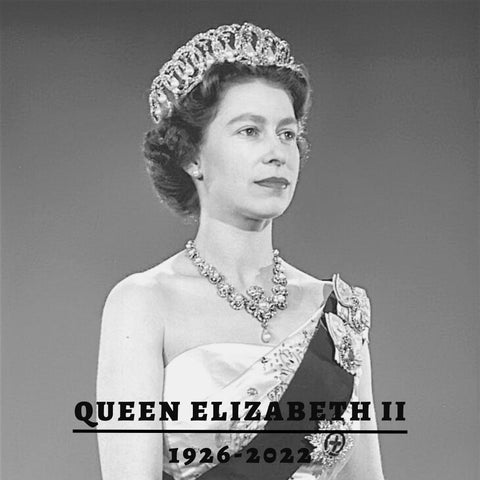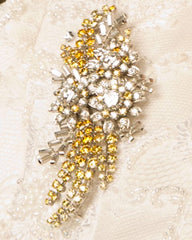Queen Elizabeth II - Jewellery with Meaning.

As the United Kingdom, Commonwealth Realms, and the world mourn Queen Elizabeth II's passing at the age of 96 and pay their respects for her seven decades of service and duty. It is no wonder her Majesty built an impressive private jewellery collection separate from the crown jewels during her reign.
The longest reigning British and female monarch's collection has over 300 pieces, including a selection of brooches, tiaras, necklaces, earrings, rings, bracelets, watches and pendants that feature various gemstones, including diamonds, Rubies, Emeralds, Sapphires, Aquamarine and Pearls, to name a few.
The collection's true value is unknown due to its historical importance, and probably none of the jewellery will ever be seen on the open market; we cannot offer an opinion on its value. The Queen's jewellery collection has played a meaningful part with every outfit she wore in the estimated 21,000 engagements she attended as Queen during her reign.
The jewellery collection is comprised of pieces commissioned by the late Queen, her beloved husband, Prince Phillip, Duke of Edinburgh, and pieces handed down through the generations. We have selected five jewellery pieces to highlight that we think would hold a special meaning for the late monarch.
 Three Strand Pearl Necklace
Three Strand Pearl Necklace
Probably the most iconic piece of jewellery associated with Queen Elizabeth II, she has rarely been seen in public without her pearls. Pearl jewellery is a tradition that dates back to some of the earliest Kings and Queens. Queen Victoria was a lover of jewellery made with the Queen of the Sea gemstone, and so was her great-great-granddaughter.
The origin of her three-strand pearl necklace is very personal; it was a gift from her beloved father, King George VI, before his death and her accession to the throne in 1952. For this reason, this is more than a piece of jewellery; and would be a constant reminder of her father and would hold a special place in the late Queen's heart.
There is a secret associated with the three-strand pearl necklace, and the secret is there is not one but three nearly identical three-strand pearl necklaces. The Queen herself, in 1953, had another one created, and the third necklace was gifted to her by the Emir of Qatar, which is slightly different as it has a diamond jewelled clasp.
The Queen rotated these different strands over the years, which are nearly indistinguishable from each other, and this has added longevity to the necklaces.
The Queen's Engagement Ring
Her Majesty's engagement ring is one of the most understated jewellery

pieces in the Queen's collection. We know that this diamond engagement ring, like the three-strand pearl necklace, would have held a deep sentimental meaning for the late Queen. Her Majesty was presented with the engagement ring in 1946 by her beloved husband of nearly 74 years, Prince Phillip, Duke of Edinburgh.
Designed by Prince Phillip, he wanted it to feature a brilliant three-carat diamond centre stone with ten smaller diamonds, five on each shoulder of the platinum setting. His mother, Princess Alice of Battenberg, gave the three-carat diamond to Prince Phillip. It was part of a tiara gifted to Princess Alice as a wedding present in 1903 by Tsar Nicholas II and Tsarina Alexandra of Russia.
The engagement announcement and ring were not publicly announced or seen till the 9th of July 1947, after the future Queen turned 21. They would be married four months later, on the 20th of November 1947, at Westminster Abbey.
This platinum engagement ring would have been a comfort and a reminder of her beloved husband after he passed away in 221 and would certainly have been amongst the Queen's most treasured possession.
The Coronation Necklace and Earrings
The coronation earrings and necklace date back to the second longest reigning monarch Queen Victoria in 1858. The earrings comprise large cushion cut diamonds with minor brilliant round diamond accents and large pear-shaped pendants. The necklace features 27 cushion-cut diamonds and a 22.48-carat diamond pendant made with the Lahore diamond.
The necklace and earrings are beautifully captured in the 1859 portrait of Queen Victoria by Franz Winterhalter. Queen Victoria wore them for both her golden and diamond jubilee photo portraits.
At the coronation of King Edward VII in 1902, Queen Alexandra wore the necklace without the pendant. Though, it's believed that Queen Alexandra may have incorporated the Lahore diamond pendant and the earrings into her elaborate jewellery-laden neckwear (This is speculation, not a fact). At the coronation of King George V in 1911, Queen Mary wore the coronation necklace and pendant. She had two diamonds removed from the necklace and had a pair of solitaire earrings made for the occasion as she preferred solitaires to drop earrings.
Queen Elizabeth (The Queen Mother), at the coronation of her husband, King George VI, wore the diamond necklace and earrings; she had the Lahore diamond pendant removed and modified, reducing the size, and they added it to her crown. After the ceremony, the Lahore diamond was removed from the crown and reunited with the necklace as a pendant.
Queen Elizabeth II became the monarch when her beloved father, King George VI, died in 1952. At her coronation on the 2nd of June 1953, her Majesty reunited the necklace, pendant and earrings for the ceremony. This is the first time the three pieces were worn as intended to a coronation by Queen Regent or Queen, some 95 years after being crafted for Queen Victoria.

Queen Elizabeth II, during her seventy-plus year reign, would wear the coronation necklace or earrings or the set for special occasions. They were amongst her favourite jewellery, and they hold a special meaning and symbolism as past Queens wore the coronation necklace and earrings in one way or another to every coronation since 1902.
Queen Mary's True Lover's Knot Brooch
Amongst the Queen's private jewellery collection are 98 plus brooches, and one of the two on our list is Queen Mary's True Lover's Knot Brooch. This large brooch was commissioned in 1932 by Queen Mary and is approximately 80mm x 58mm in size, which is oversized. Made from silver and gold in a bow-shaped, with a unique feature as the tails are adjustable and set with brilliant-cut diamond for that extra sparkle.
Queen Elizabeth II inherited the True Lover's Brooch in 1953 from her
 grandmother.
grandmother.The brooch continued throughout the 70s, 80s, and 90s to be used for significant events. In 1998 the Queen for the state banquet for the Japanese Emperor Akihito, she paired the True Lover's Knot Brooch with the coronation necklace and earrings. These favourite jewellery pieces would be combined again in 2001 at another state banquet for South African President Mbeki. In 2011, the Queen wore it with her three-strand pearl necklace to the wedding of her grandson William the new Prince of Wales and Catherine, Princess of Wales.
The Australian Wattle Spray Brooch

Queen Elizabeth, during her 1954 visit to Australia, was gifted with a platinum brooch with yellow and colourless (white) diamonds in the form of a wattle spray and tea tree blossom by Prime Minister Sir Robert Menzies.
The Australian Wattle Spray Brooch would accompany Queen Elizabeth on her next fifteen trips to Australia, including the opening of the Sydney Opera House in 1973, the New Parliament House in 1988, the Sydney Olympics in 2000, and her visits in 2006 and 2011.
From her first visit to Australia in 1954, the Queen visited 16 times during her reign, second only to Canada for the most visited country outside of the United Kingdom. The Queen had a deep love for Australia and its people.
Conclusion
Queen Elizabeth II had an outstanding privately owned jewellery collection that included more than 98 brooches, over 50 tiaras, 46-plus necklaces, 37 or more bracelets, exceeding 34 pairs of earrings, at least 15 rings, 14 watches and a number of pendants.
During her long life and reign as monarch, the Queen shared her collection with other royal family members, including Camilla, Queen Consort, Catherine, Princess of Wales, Countess Sophie of Wessex and Princesses Beatrice and Eugenie, to mark special occasions.
We selected five pieces to highlight that would have had a special meaning for the Queen during her life. Whether they reminded her of a loved one such as her father, King George VI, her grandmother Queen Mary, or her beloved husband, Prince Phillip, Duke of Edinburgh, or to mark special events or places. We are confident that her Majesty would agree that each piece and many more in the collection would mean something special to her.
Many have asked who will inherit the jewellery collection after the Queen's passing. Most may pass directly to King Charles III in keeping tradition, and some unique pieces might pass to other royal family members. As the Queen's will is private, we must wait and keep an eye out.










Leave a comment